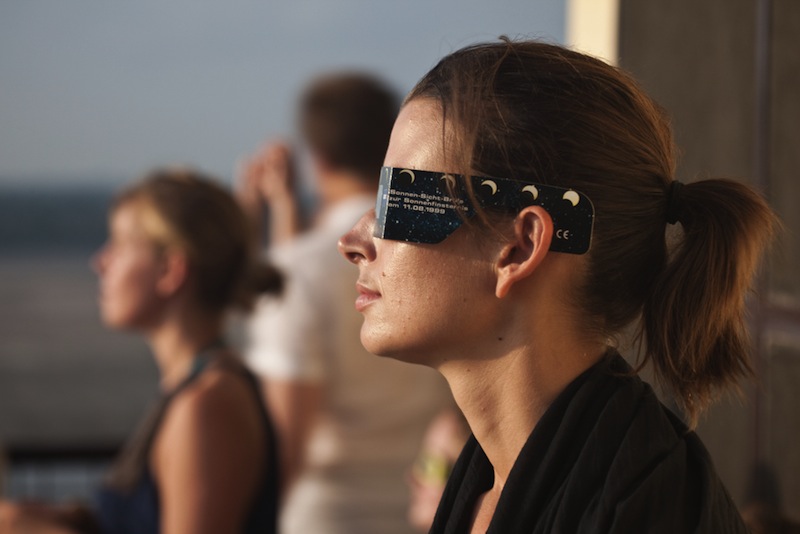Can a Solar Eclipse Really Blind You?

People across the United States will have the chance to see a total solar eclipse on Aug. 21, the first time the spectacle was viewable from the continental U.S. since 1979. While it may be tempting to brush off warnings about looking up at this eclipse bare-eyed, don't: The light of an eclipse really can damage your eyes — though warnings of total blindness may be overstated.
The condition is called solar retinopathy, and it occurs when bright light from the sun floods the retina on the back of the eyeball. The retina is home to the light-sensing cells that make vision possible. When they're over-stimulated by sunlight, they release a flood of communication chemicals that can damage the retina. This damage is often painless, so people don't realize what they're doing to their vision.
- 2017 Total Solar Eclipse: Everything You Need to Know
- Find the Best Places to Watch the Total Solar Eclipse with NASA Maps (Photos)
Solar retinopathy can be caused by staring at the sun (regardless of its phase), but few people can stand to look directly at our nearest star for very long without pain. It does happen occasionally — medical journals record cases in which people high on drugs have stared at the sun for long periods of time, causing serious damage. Adherents of sun-worshipping religious sects are also victims. In 1988, for example, Italian ophthalmologists treated 66 people for solar retinopathy after a sun-staring ritual.
But during a solar eclipse, more people are at risk. With the sun almost covered, it's comfortable to stare, and protective reflexes like blinking and pupil contraction are a lot less likely to kick in than on a normal day. Even pets are vulnerable to eye damage from looking at an eclipse, though they don't tend to look directly at the sun. Even so, if they're with you during your eclipse outing, your furry friends should wear protective glasses as well.
Damaged eyes
Early observers of astronomy sometimes found out about solar retinopathy the hard way. Thomas Harriot, who observed sunspots in 1610 but did not publish his discovery, wrote in 1612 that after viewing the sun his "sight was dim for an hour." Oxford astronomer John Greaves was once quoted as saying that after sun observations, he saw afterimages that looked like a flock of crows in his vision. In the most famous case of all, Isaac Newton tried looking at the sun in a mirror, essentially blinding himself for three days and experiencing afterimages for months.
Scientists don't have a good bead on the prevalence of eye damage after a solar eclipse. In one study, conducted in 1999 after a solar eclipse visible in Europe, 45 patients with possible solar retinopathy showed up at an eye clinic in Leicester in the United Kingdom after viewing the eclipse. Forty were confirmed to have some sort of damage or symptoms of damage; five of those had visible changes in their retina.
Twenty of the patients reported eye pain, while another 20 reported problems with vision. Of the latter group, 12 reported that their sight had returned to normal seven months later, but four could still see the ghosts of the damage in their visual field, such as a crescent-shaped spot visible in dim light. [If the Sun Is 93 Million Miles Away, Why Can't We Look Directly at It?]
Get the world’s most fascinating discoveries delivered straight to your inbox.
"Our series demonstrates that, contrary to popular belief, the majority of people with eclipse retinopathy are not totally blinded," the researchers wrote in 2001 in the journal The Lancet. However, they warned, earlier post-eclipse studies had turned up more severe problems in patients, suggesting that widespread media warnings not to look at the eclipsing sun may have prevented more damage during recent eclipses.
Safe eclipse viewing
Research also suggests that while a lot of the damage may heal, some may be permanent. One 1995 study followed 58 patients who sustained eye damage after viewing a 1976 eclipse in Turkey. Healing occurred during the first month after the eclipse, the researchers reported in the journal Graefe's Archive for Clinical and Experimental Ophthalmology, but by 18 months, whatever damage remained was permanent up to 15 years later.
So, while it might be tough to go totally blind by looking at an eclipse, doing so without proper protection could leave a long-lasting stain on your vision. The only safe way to view an eclipse, according to NASA, is to use specially designed sun filters, often available at telescope stores, or to wear No. 14 welder's glasses, available at welding specialty stores. Pinhole viewers — essentially a hole in a piece of cardboard or paper — can also be used to view the eclipse indirectly by casting a shadow of the sun on the ground or on a screen. [How to Build a Solar Eclipse Viewer: Photos]
REMEMBER not to stare directly at the sun without protective eyewear during the Aug. 21 total solar eclipse. If you don't have certified eclipse viewers, you can also make a pinhole camera viewer that will allow you to see the eclipse without looking at the sun directly.
Editor's Note: This article was first published in 2012 and updated for the Great American Solar Eclipse in 2017.
Originally published on Live Science.

Stephanie Pappas is a contributing writer for Live Science, covering topics ranging from geoscience to archaeology to the human brain and behavior. She was previously a senior writer for Live Science but is now a freelancer based in Denver, Colorado, and regularly contributes to Scientific American and The Monitor, the monthly magazine of the American Psychological Association. Stephanie received a bachelor's degree in psychology from the University of South Carolina and a graduate certificate in science communication from the University of California, Santa Cruz.
 Live Science Plus
Live Science Plus





